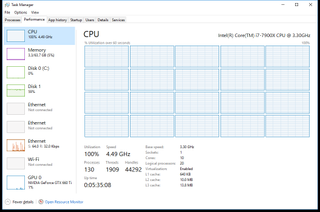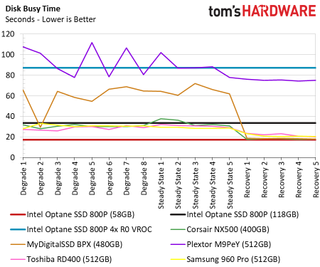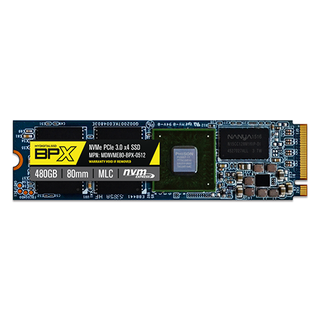Intel Optane SSD 800P Review: Swift, Small-Capacity XPoint
Why you can trust Tom's Hardware
Intel Optane SSD 800P Performance Testing
Comparison Products
We're comparing the new Optane SSD 800P models to 512GB-class SSDs. The 118GB drive is $199, so its pricing slots in the middle of the 512GB SATA and NVMe products. Larger 512GB-class SSDs have become the top choice for enthusiasts as prices have leveled off from the flash shortage. We're also testing four 118GB Optane 800P drives in RAID 0. That gives us 472GB of capacity, which is very close to the competing 480GB - 512GB SSDs. Of course, you'll pay much more with Optane to match the capacity of the flash-based SSDs.
We have three Optane SSD 800P products in the charts, which only leaves us with a few slots for comparison products. The 400GB Corsair Neutron NX500 and 512GB Samsung 960 Pro target power users, enthusiasts, and workstation users with demanding workloads. The MyDigitalSSD BPX is a very popular low-cost NVMe SSD that debuted in 2017. The Plextor M9Pe and Toshiba RD400 both have 512GB of usable capacity and fit in the mid-range pricing tier.
Testing With VROC
We used Asrock's new Fatal1ty X299 Professional Gaming i9 XE motherboard and Asrock's new Ultra Quad M.2 adapter for our tests. The Ultra Quad adapter houses up to four M.2 NVMe SSDs in a single add-in card. That allows us to use Intel's CPU-powered VROC (Virtual RAID on CPU) storage array feature with four 800P SSDs.
Sequential Read Performance
To read about our storage tests in-depth, please check out How We Test HDDs And SSDs. We cover four-corner testing on page six of our How We Test guide.


The Intel Optane SSD 900P models deliver roughly 2,500 MB/s of sequential read performance with an enterprise-class controller that is only matched by its enterprise-class power consumption. We want that level of performance in a smaller and more widely-compatible form factor, but the 800P trades some performance to fit within the M.2 size and power limits. We recorded 1,500 MB/s with a single worker during our burst testing.
Sequential Write Performance


The 800P's sequential write performance is lackluster compared to most other NVMe SSDs on the market. Both Optane 800P SSDs delivered 650 MB/s at QD2. That's nearly half the performance of the slowest NAND-based NVMe SSD in our test. You can regain some of that lost performance with VROC in a RAID 0 array. The four-drive RAID array reaches flash-like levels of performance at QD2, but it doesn't surpass the 960 Pro until QD4.
Random Read Performance



Intel designed Optane to boost real-world application workloads, which tend to consist of random I/O operations. As a result, Optane dominates flash-based SSDs in our random read tests. Flash-based NVMe SSDs like the new Samsung 980 OEM SSD crest the 15,000 IOPS mark at QD1, which is the highest we've recorded with a normal SSD. The Optane SSD 800P surpasses 50,000 IOPS at QD1. That's a big number, but what it represents is more important: the Optane SSDs have exceptionally low latency. 4KB random reads make up the majority of normal desktop PC workloads, so lower latency equates directly to a snappier user experience.
We've tested VROC technology several times and recorded increased latency at low queue depths. The four-drive Optane array still has higher latency at low queue depths than a single 800P drive, but it is still better than flash-based products.
Random Write Performance



We expected to see higher random write performance from the 800P SSDs and array. Chart-topping random write performance isn't a critical requirement for many applications, but the Optane SSDs could use some improvement here. We think Intel has intentionally hamstrung random write performance on the consumer Optane SSDs (including the 900P) to prevent data centers from using them in servers.
70% Mixed Sequential Workload
We describe our mixed workload testing in detail here and describe our steady state tests here.


We've tested VROC with several types of storage devices and found that it works best with heavy sequential workloads. The mixed sequential workload shows how users can leverage VROC to accelerate these workloads in unprecedented ways.
The two Optane SSD 800P drives fall short of 1,000 MB/s in the same test, which is a result of their low sequential write speed.
70% Mixed Random Workload


In much the same way, the high random read performance boosts the mixed random test. VROC doesn't trail too far behind at QD2, but there is still a small penalty. At QD4, the VROC array towers over the two 800P drives.
Sequential Steady-State



Steady-state conditions don't impact the Optane 800Ps, so they pass through our sequential test with ease. You'll only see heavy workloads like the one we use for preconditioning in niche applications. This isn't simply converting a large movie file to another large movie file, but rather the kind of workloads you see when you compile CAD files.

The four Optane 800P SSDs in a RAID 0 array didn't fare as well as the single drives. We write to the drives for ten hours during the preconditioning phase. The VROC array delivers nearly 2,400 MB/s during most of the workload. CPU utilization climbs dramatically when we start mixing in a higher percentage of read requests into the workload. Eventually, all ten cores hit 100% utilization even though we have overclocked the processor to 4.5 GHz. We observed this same tendency during other long sustained workloads. We have not encountered this issue with NAND-based SSDs in a VROC RAID.
Random Steady-State


Tight timelines and stingy sample allocations mean we rarely have the opportunity to show RAID 0 and single drive performance side-by-side in our launch day reviews. With that said, this test tells us which drives will perform well in an array because it pushes each SSD into its lowest possible performance state. Storage devices that deliver a smooth performance profile free of large peaks or valleys work best in arrays. SSDs with less deviation are better because a RAID array amplifies the impact of I/O outliers. We get to see that in action today with the Optane SSD 800P.
The Optane 800P is a very good drive to use in a RAID array. The Optane 900P is the only semi-affordable drive that is better.
PCMark 8 Real-World Software Performance
For details on our real-world software performance testing, please click here.










Until this point, most of the 800P results are impressive and the weak points come in areas where performance is sufficient enough to overlook. Application performance is a different story. The 800P is a fast SSD, but that performance doesn't always carry over to simple applications. Operating systems still lack sufficient support for high-speed storage devices even though we've had consumer SSDs for nearly a decade. Microsoft has made strides to tune some areas, but it hasn't done enough to utilize flash, much less 3D XPoint, as well as it could.
Application Storage Bandwidth

The Optane SSD 800P does make your system feel remarkably fast in Windows, though. We tested the 800P in a workstation-class notebook and it came to life, easily beating the OEM storage in responsiveness and snappiness. But it didn't feel significantly faster than a 2TB 960 Pro. The system was more responsive, but you only feel the difference in small doses rather than the night and day difference you notice when you come from spinning disks to flash.
The average application throughput score shows exactly what we experienced. The Optane 800P is slightly faster than a very good NVMe SSD, but it's not a revolutionary change.
PCMark 8 Advanced Workload Performance
To learn how we test advanced workload performance, please click here.



The VROC array suffered from the same CPU utilization issue during our PCMark 8 Extended Storage Test. This test takes around 24 hours and starts off with a very heavy workload, much like our sequential steady-state test.
The VROC performance is easy to explain away because the technology is new and Intel is still somewhat guarded about the details. The performance difference between the 58GB and 118GB Optane SSD 800P drives is not as easy to explain. We initially tested the two drives on different systems with identical hardware on an ROG Maximus IX APEX platform. We then swapped the drives between the systems and came away with the same results. The 58GB 800P scored significantly higher than the 118GB model in both systems.
Total Service Time



Low latency is the main attraction of the Optane SSD 800P, but you can get nearly identical results in Windows with normal flash-based SSDs. The recovery phase of the PCMark 8 Extended Storage Test shows the Optane 800P 58GB in the same vicinity as several other high-performance NVMe drives.
Disk Busy Time

The 58GB 800P didn't have to work as long as the other drives to complete the workload, including the 118GB 800P and the VROC array.
BAPCo SYSmark 2014 SE Responsiveness Test


We run our BAPCo tests on a Lenovo Y700-17 notebook, but the 58GB 800P sits on the sideline. The drive doesn't have enough capacity to hold the operating system and the BAPCo software.
The results are disheartening, to say the least. We do know why some of the performance results didn't line up with our expectations, though. The device manager does not allow us to "check the box" in device properties that alters the Intel Optane SSD 800P's write-cache settings. We test all devices with write-cache buffer flushing disabled, but Intel locks the feature out. The setting is also locked for the Optane SSD 900P, but Intel's custom NVMe driver modifies the cache with specific optimizations. Intel didn't make a custom NVMe driver available to us for the 800P, and we aren't sure if it will develop one in the future. We hope Intel provides a custom NVMe driver for the 800P because it has a tremendous impact on system responsiveness, which is obviously not where it should be for a product with premium pricing.
BAPCo MobileMark 2012.5 Notebook Battery Life
To learn how we test advanced workload performance, please click here.


Only a handful of notebooks support Optane Memory, so the 800P gives us our first look at Optane in a portable system. We use the same Lenovo Y700-17 gaming notebook for the BAPCo MobileMark test. Optane has a reputation of being power hungry, but we came away impressed with the amount of time the system gave us on battery power. The 800P delivers roughly the same battery life as the 512GB Plextor M9Pe.
MORE: Best SSDs
MORE: How We Test HDDs And SSDs
MORE: All SSD Content
Current page: Intel Optane SSD 800P Performance Testing
Prev Page Features & Specifications Next Page Final ThoughtsStay on the Cutting Edge
Join the experts who read Tom's Hardware for the inside track on enthusiast PC tech news — and have for over 25 years. We'll send breaking news and in-depth reviews of CPUs, GPUs, AI, maker hardware and more straight to your inbox.
-
derekullo Does Smart Response still have the 64 gigabyte limit on the maximum size of the cache?Reply -
CRamseyer Yes but when configured as Optane Memory it seems to take the entire drive for cache.Reply -
2Be_or_Not2Be I would have liked to see the 900p performance included in the graphs. Then you could tell how much "performance" you're losing by going down to the 800p.Reply -
CRamseyer That's why we have the performance charts on the final page. We wanted to get in the 900P and Optane Memory charted but didn't want to make all Optane results in the main testing portion of the review. You will see 800P, 900P VROC, and PCH RAID coming up soon together in a review.Reply -
TomHaX Fast? Intel claims the new Optane SSD 800P series is capable of up to 1,450/640 MB/s of sequential read/write throughput. Random performance reaches up to 250,000 read and 140,000 write IOPS.Reply
That is SLOW. Compare to gold standard: Samsung 960 Pro 2TB:
Sequential Read Speed: 3,500 MB/sec
Sequential Write Speed: Max 2,100 MB/sec
RANDOM READ (4KB, QD32): 440,000 IOPS (Thread 4)
RANDOM WRITE (4KB, QD32): 360,000 IOPS (Thread 4)
http://www.samsung.com/semiconductor/minisite/ssd/product/consumer/960pro
Stop FUD. Get the facts! -
natx808 price/performance is not doing it for me. I'd take a cheap adata XPG SX8000 256 GB instead.Reply
i'm not sure what consumer application would suits these drives for considering such small density. not much room left for games once you install the OS on a 64 or even 128GB drive
disappointing 4k random write performance compared to drives that cost a fraction of the optane drives. I suppose the average consumer isn't going to be running a heavily loaded database server, but regardless i would just as soon opt for nvme drives than optane.
Question - whats the purpose to show 4 R0 optane if you don't compare it to 4 R0 SSDs?
-
DavidC1 To Chris, the author:Reply
You guys should update your SSD articles to include 760p in the comparison. It's the top drive when it comes to battery life, and power restricted performance, which is a nice balance for notebooks. -
TikoL Intel inside, Idiot outside. Only an idiot will buy this product vs. Samsung 960 pro SSD.Reply -
rilebru Once I watched a documentary in which a whale washed ashore exploded like a water fountain spraying blood and all other disgusting bodily fluids. This is because it was bloated. How come I don’t see that whale on packaging of Optane products now?Reply



